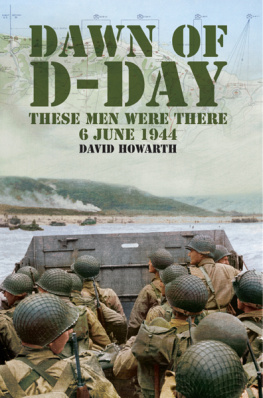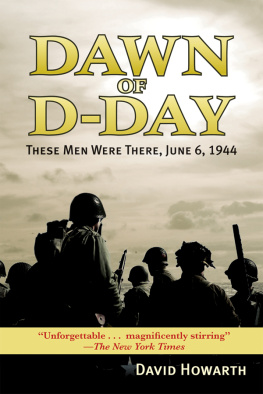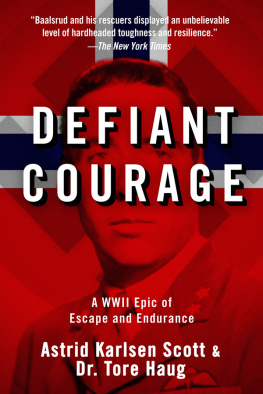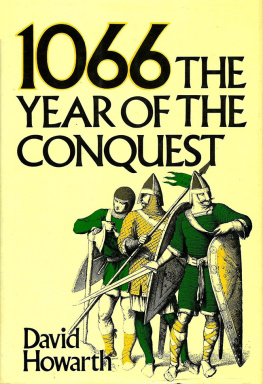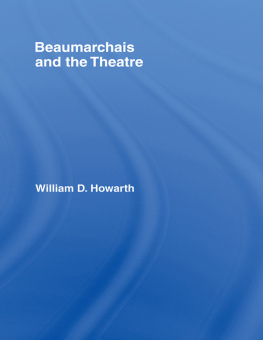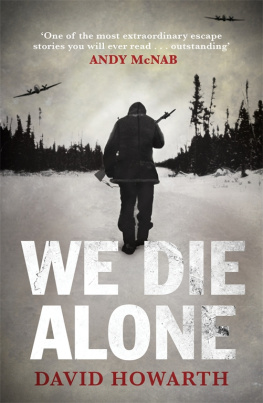Howarth - We Die Alone: a WWII Epic of Escape and Endurance
Here you can read online Howarth - We Die Alone: a WWII Epic of Escape and Endurance full text of the book (entire story) in english for free. Download pdf and epub, get meaning, cover and reviews about this ebook. year: 2007, publisher: Lyons Press, genre: Detective and thriller. Description of the work, (preface) as well as reviews are available. Best literature library LitArk.com created for fans of good reading and offers a wide selection of genres:
Romance novel
Science fiction
Adventure
Detective
Science
History
Home and family
Prose
Art
Politics
Computer
Non-fiction
Religion
Business
Children
Humor
Choose a favorite category and find really read worthwhile books. Enjoy immersion in the world of imagination, feel the emotions of the characters or learn something new for yourself, make an fascinating discovery.

- Book:We Die Alone: a WWII Epic of Escape and Endurance
- Author:
- Publisher:Lyons Press
- Genre:
- Year:2007
- Rating:4 / 5
- Favourites:Add to favourites
- Your mark:
- 80
- 1
- 2
- 3
- 4
- 5
We Die Alone: a WWII Epic of Escape and Endurance: summary, description and annotation
We offer to read an annotation, description, summary or preface (depends on what the author of the book "We Die Alone: a WWII Epic of Escape and Endurance" wrote himself). If you haven't found the necessary information about the book — write in the comments, we will try to find it.
Howarth: author's other books
Who wrote We Die Alone: a WWII Epic of Escape and Endurance? Find out the surname, the name of the author of the book and a list of all author's works by series.
We Die Alone: a WWII Epic of Escape and Endurance — read online for free the complete book (whole text) full work
Below is the text of the book, divided by pages. System saving the place of the last page read, allows you to conveniently read the book "We Die Alone: a WWII Epic of Escape and Endurance" online for free, without having to search again every time where you left off. Put a bookmark, and you can go to the page where you finished reading at any time.
Font size:
Interval:
Bookmark:
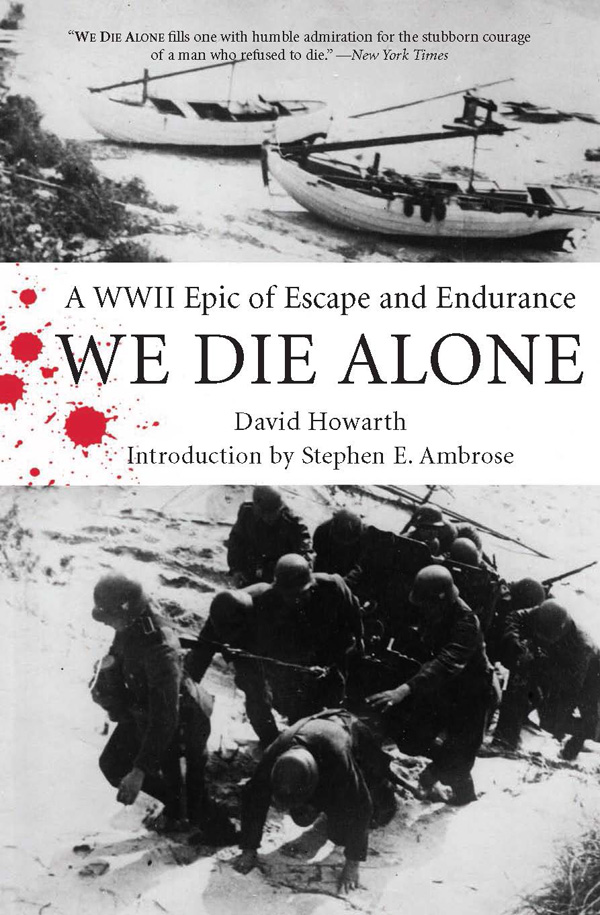
WE DIE ALONE
WE DIE ALONE
A WWII Epic of Escape and Endurance
David Howarth
Introduction by Stephen E. Ambrose

THE LYONS PRESS
Guilford, Connecticut
An imprint of The Globe Pequot Press
Copyright 1955 by David Howarth
Introduction copyright 1999 by Stephen E. Ambrose
ALL RIGHTS RESERVED. No part of this book may be reproduced or transmitted in any form by any means, electronic or mechanical, including photocopying and recording, or by any information storage and retrieval system, except as may be expressly permitted in writing from the publisher. Requests for permission should be addressed to The Lyons Press, Attn: Rights and Permissions Department, P.O. Box 480, Guilford, CT 06437.
The Lyons Press is an imprint of The Globe Pequot Press.
Originally published in 1955 by The Macmillan Company, New York.
First Lyons Press edition, 1999
ISBN 978-0-7627-9603-8
Library of Congress Cataloging-in-Publication Data is available on file.
On mourra seul
PASCAL
16231662
CONTENTS
FOREWORD
I WRITE FOR A LIVING , which means I spend much of my time reading, whether books or documents or memoirs or whatever, to provide material for my writing. I seldom read novels but I do read stories of men caught in unusual circumstances or doing things that are remarkable. My research gives me wonderful books to read, including such favorites as The Journals of Lewis and Clark or Dwight D. Eisenhowers Crusade in Europe or Richard Nixons Presidential Memoirs or Ulysses S. Grants Memoirs. Reading for pleasure, on the other hand, usually gives me an escape from work and on the rarest of occasions something to remember and on a very few occasionsI can count them on less than the fingers of one handa book that I absolutely cannot put down until Ive finished it and one that I can never forget. These are Charles Fraziers Cold Mountain, E. B. Sledges With the Old Breed, Slavomir Rawiczs The Long Walk, and now David Howarths We Die Alone.
We Die Alone is set in 1943 and is about World War II. Yet it is a very unusual story of war, for in it fewer than a dozen men get killed by enemy fire, and it is an account of a failed mission. Looking back, the mission might seem foolhardy. But the men who planned it worked as carefully as they could, and the men who went to carry it out did so knowing that the risks were great and the stakes were high.
Simply put, a small boat sailed from the Shetland Islandsthe most northerly part of Britainto Nazi-occupied Norway. The boat contained a dozen Norwegian commandos who wanted to help free their country. Trained in Britain, they were being sent to organize some resistance to the German occupiers and to gather information about German attacks on the convoys sailing to the Soviet Union. But in their own homeland, they were betrayed, and all but one were killed.
The survivor was Jan Baalsrud, and this is his story. There is almost no action in it; instead it is a story of perseverance such as the world has seldom, if ever, seen before or sincethe perseverance of Jan and the villagers of the far north of Norway. The men and women who helped Jan, who ceaselessly risked their own lives to save his, even when he was apparently a hopeless cripple with nothing whatsoever to offer anyone, and managed impossible-to-believe feats in keeping him alive. But though he did not know it himself, Jan did have something to offer them. He offered them, the people of an occupied nation, the chance to strike back. Outwitting the Nazis, they eventually got him to neutral Sweden with help from the Lapps, who are themselves about as memorable as it is possible to be.
Jan astonishes us with his bravery and endurance. So do the villagers. His actions came because of his will to live, and because of his hatred of Hitler and his Nazis. Hitler had sown a lot of hate around the world. He got it in return. The Jews hated him and his Nazis, as did the Russians, the Poles, the Yugoslavs, the French, the Americans, the Danes, the Norwegians, and many others. The young men from these groups signed up to fight against the Germans. Jan was one of them. What he didwhat all the Norwegians and Lapps didmust be admired. In Jans case, we are all of us struck dumb by his bravery and endurance, which astonish everyone.
Stephen E. Ambrose
PREFACE
I HEARD THE bare bones of this story during the war, soon after it happened, and I mentioned it briefly in my book The Shetland Bus. All that I knew about it then was based on a report which was written in a Swedish hospital by a man called Jan Baalsrud. It was a graphic report, but Baalsrud was very ill when he wrote it, and it left a lot unsaid. One could see that there was much more in the story, some things which Baalsrud had forgotten and others he had never known, although he played the main part in it. But it was not until ten years later that I had a chance to talk it over with him, and persuade him to come with me to the far north of Norway where it happened, to try to find out the whole truth of it.
Now that I have found it out and written it down, I am rather afraid of being accused of exaggeration. Parts of it are difficult to believe. But I have seen nearly all the places which are mentioned in this book, and met nearly all the people. Not one of the people knew the whole story, but each of them had a most vivid recollection of his own part in it. Each of their individual stories fit together, and also confirm what Baalsrud himself remembered. Some minor events are matters of deduction, but none of it is imaginary. Here and there I have altered a name or an unimportant detail to avoid offending people; but otherwise, I am convinced that this account is true.
WE DIE ALONE
1. LANDFALL
EVEN AT the end of March, on the Arctic coast of northern Norway, there is no sign of spring. By then, the polar winter night is over. At midwinter, it has been dark all day; at midsummer, the sun will shine all night; and in between, at the vernal equinox, the days draw out so quickly that each one is noticeably longer than the last. But the whole land is still covered thickly with ice and snow to the very edge of the sea. There is nothing green at all: no flowers or grass, and no buds on the stunted trees. Sometimes there are clear days at that time of year, and then the coast glitters with a blinding brilliance in the sunlight; but more often it is swept by high winds and hidden by frozen mist and driven snow.
It was on that coast, on the 29th of March, 1943, that this story really began. On that day a fishing-boat made landfall there, six days out from the Shetland Islands, with twelve men on board. Its arrival in those distant enemy waters in the third year of the war, within sight of a land which was occupied by the Germans, was the result of a lot of thought and careful preparation; but within a day of its arrival all the plans which had been made were blown to pieces, and everything which happened after that, the tragedies and adventures and self-sacrifice, and the single triumph, was simply a matter of chance; not the outcome of any plan at all, but only of luck, both good and bad, and of courage and faithfulness.
That particular day was sunny, as it happened, and the twelve men watched it dawn with intense excitement. It is always exciting to make the land after a dangerous voyage; the more so when ones ship approaches the land at night, so that when daylight comes a coast is revealed already close at hand. In that landfall there was an extra excitement for those men, because they were all Norwegians, and most of them were about to see their homeland for the first time since they had been driven out of it by the German invasion nearly three years before. Above all, here was the supreme excitement of playing a dangerous game. Eight of the twelve were the crew of the fishing-boat. They had sailed it safely across a thousand miles of the no-mans-land of ocean, and had to sail it back when they had landed their passengers and cargo. The other four were soldiers trained in guerrilla warfare. Their journey had two objectives, one general and one particular. In general, they were to establish themselves ashore and spend the summer training the local people in the arts of sabotage; and in particular, in the following autumn they were to attack a great German military airfield called Bardufoss. In the hold of the boat, they had eight tons of explosives, weapons, food and arctic equipment, and three radio transmitters.
Font size:
Interval:
Bookmark:
Similar books «We Die Alone: a WWII Epic of Escape and Endurance»
Look at similar books to We Die Alone: a WWII Epic of Escape and Endurance. We have selected literature similar in name and meaning in the hope of providing readers with more options to find new, interesting, not yet read works.
Discussion, reviews of the book We Die Alone: a WWII Epic of Escape and Endurance and just readers' own opinions. Leave your comments, write what you think about the work, its meaning or the main characters. Specify what exactly you liked and what you didn't like, and why you think so.

